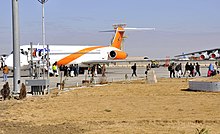
Back আফগানিস্তানের পরিবহন ব্যবস্থা Bengali/Bangla Transporte en Afganistán Spanish ترابری در افغانستان Persian Transports en Afghanistan French Afganisztán közlekedése Hungarian アフガニスタンの交通 Japanese 아프가니스탄의 교통 Korean Afganistano transportas Lithuanian Transport w Afganistanie Polish په افغانستان کې لېږد را لېږد Pashto/Pushto


Transport in Afghanistan is done mostly by road, rail and air.[1][2] Much of the nation's road network was built in the mid-20th century but left to ruin during the last two decades of that century due to war and political turmoil. Officials of the current Islamic Emirate have continued to improve the national highways, roads, and bridges.[3] In 2008, there were about 700,000 vehicles registered in Kabul.[4][5] At least 1,314 traffic collisions were reported in 2022.[6]
Landlocked Afghanistan has no seaports, but the Amu River, which forms part of the nation's border with Turkmenistan, Uzbekistan and Tajikistan, does have substantial traffic. Rebuilding and expanding its airports, roads, rail network, and land ports has led to rapid economic growth in recent years. There are 46 airports in Afghanistan as of 2021.[7]
- ^ Cite error: The named reference
500,000 metric tons of goods imported, exported via railroadswas invoked but never defined (see the help page). - ^ "ACCI: Transit Through Afghanistan Up 50%". TOLOnews. October 19, 2022. Retrieved 2022-10-24.
- ^ "Reconstruction". Afghanistan: Pajhwok Afghan News. June 22, 2022. Retrieved 2022-06-22.
- ^ Cite error: The named reference
whowas invoked but never defined (see the help page). - ^ Cite error: The named reference
Afghanistan gives antiquated Toyotas a new lifewas invoked but never defined (see the help page). - ^ Cite error: The named reference
Nearly 3,000 people killed, injured in traffic accidents in past 9-monthwas invoked but never defined (see the help page). - ^ "Afghanistan". The World Factbook. United States: Central Intelligence Agency (CIA). Retrieved 2017-12-01.
© MMXXIII Rich X Search. We shall prevail. All rights reserved. Rich X Search